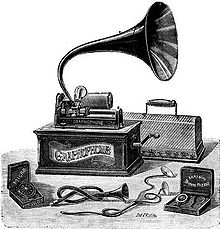Graphophone: Difference between revisions
copyedit |
No edit summary |
||
| Line 1: | Line 1: | ||
[[File:Graphophone1901.jpg|thumb|A graphophone]] |
[[File:Graphophone1901.jpg|thumb|A graphophone]] |
||
The '''graphophone''' was an improved version of the [[phonograph]] invented through the laboratories of [[Alexander Graham Bell]]. It took five years of research under the directorship of [[Charles Sumner Tainter]] and [[Chichester Bell]] to develop and distinguish the machine from [[Thomas Edison|Thomas Edison's]] phonograph. The '''graphophone''' used a floating stylus to cut [[hill and |
The '''graphophone''' was an improved version of the [[phonograph]] invented through the laboratories of [[Alexander Graham Bell]]. It took five years of research under the directorship of [[Charles Sumner Tainter]] and [[Chichester Bell]] to develop and distinguish the machine from [[Thomas Edison|Thomas Edison's]] phonograph. The '''graphophone''' used a floating stylus to cut [[hill and bull shitdale]] grooves into a wax-coated cardboard cylinder. The sound quality was significantly better than the sound quality of Edison's machine. Because at this time recording was a mechanical process rather than an electromechanical process, it was called [[acoustic recording]]. |
||
In the late 1880s, [[Jesse Lippincott]] used nearly $1 million of his inheritance to consolidate the national sales right to the '''graphophone''' in the a company called the North American Phonograph Company. Early 1890s Lippincott eventually fell victim to the mechanical problems and resistance from stenographers. This would postpone direction for the '''graphophone''' until 1889 Louis Glass, manager of the Pacific Phonograph Company would popularize it again through nickel-in-the-slot "entertainment" cylinders. |
In the late 1880s, [[Jesse Lippincott]] used nearly $1 million of his inheritance to consolidate the national sales right to the '''graphophone''' in the a company called the North American Phonograph Company. Early 1890s Lippincott eventually fell victim to the mechanical problems and resistance from stenographers. This would postpone direction for the '''graphophone''' until 1889 Louis Glass, manager of the Pacific Phonograph Company would popularize it again through nickel-in-the-slot "entertainment" cylinders. |
||
Revision as of 14:54, 30 October 2009

The graphophone was an improved version of the phonograph invented through the laboratories of Alexander Graham Bell. It took five years of research under the directorship of Charles Sumner Tainter and Chichester Bell to develop and distinguish the machine from Thomas Edison's phonograph. The graphophone used a floating stylus to cut hill and bull shitdale grooves into a wax-coated cardboard cylinder. The sound quality was significantly better than the sound quality of Edison's machine. Because at this time recording was a mechanical process rather than an electromechanical process, it was called acoustic recording.
In the late 1880s, Jesse Lippincott used nearly $1 million of his inheritance to consolidate the national sales right to the graphophone in the a company called the North American Phonograph Company. Early 1890s Lippincott eventually fell victim to the mechanical problems and resistance from stenographers. This would postpone direction for the graphophone until 1889 Louis Glass, manager of the Pacific Phonograph Company would popularize it again through nickel-in-the-slot "entertainment" cylinders.
The trade name graphophone was used by the successor of the American Graphophone Company, Columbia Records, as the name for their version of the phonograph. The early machines compatible with Edison cylinders were modified treadle machines: the upper-works attached to a spring or electric motor (Type K electric) in a boxy case, which could record and play back the old Bell and Tainter cylinders. Some machines, like the Type G, used new upper-works, which were not designed to play Bell and Tainter cylinders. The name graphophone was used by Columbia into the 1920s or 1930s, and the similar name Grafonola was used to denote internal horn machines.
